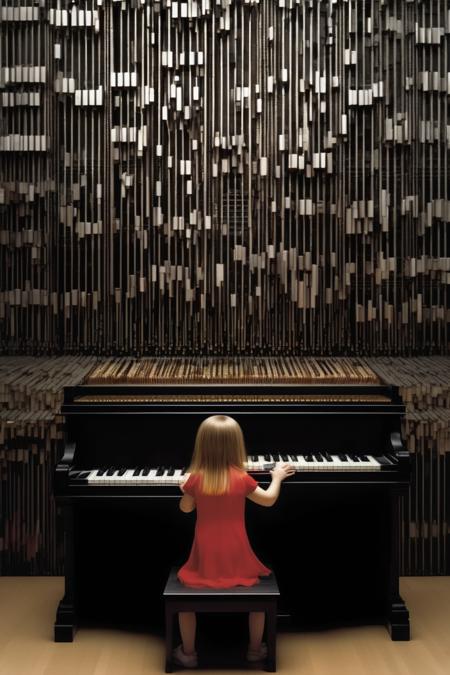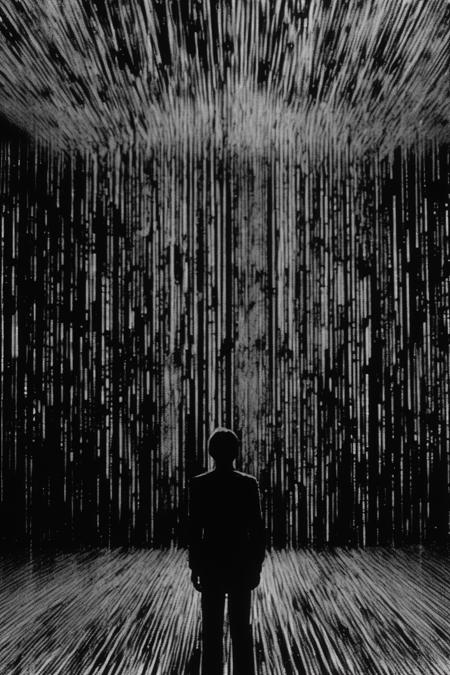Ryoji Ikeda Style (CivitAI
Ryoji Ikeda Style - A little girl plays the piano surrounded by keys, extending to infinity,Photo in the style of Andreas Gursky
Ryoji Ikeda is a Japanese visual and sound artist known for his innovative and immersive works that explore the intersections of art, science, and technology.
His style can be described as minimalist, abstract, and heavily influenced by mathematics and data. Ikeda often incorporates elements of sound, light, and visual projections in his installations and performances.
Ikeda's works often revolve around the concept of data and information, exploring its impact on our perception and understanding of the world. He utilizes complex algorithms, numerical sequences, and digital processing to create mesmerizing audiovisual experiences.
His installations often feature large-scale projections, pulsating lights, and precise audio compositions that generate a sense of sensory overload. Through his work, Ikeda aims to challenge our perception of space, time, and the boundaries of human comprehension.
Ikeda's art frequently engages with themes of digital culture, the nature of sound, and the relationship between technology and society. His immersive installations and performances have been exhibited and performed worldwide, garnering critical acclaim and recognition.
Ryoji Ikeda's innovative approach to combining sound, light, and data has positioned him as a leading figure in the field of contemporary art and audiovisual experimentation. His works offer viewers a unique and captivating exploration of the complex relationship between art, technology, and the vast realm of information.
Image examples for the model:
Ryoji Ikeda Style - create an immersive interactive digital art installation based on the work of Ryoji Ikeda
Ryoji Ikeda Style - cybercore Visualize a journey to the world of passpords and keypasses, an abstract representation of the concept of privacy's boundary. The style should blend the exquisite light manipulations of Tokujin Yoshioka with the surrealistic space imagery of Josip Demirovic Devj. The journey should encapsulate the transition from radiant luminosity to the edge of darkness, echoing the delicate balance between light and shadow. Use a color palette of radiant whites fading into deeper blacks, showcasing the journey from light to darkness. Capture this narrative through a wide-angle lens, displaying the vastness of this infinite journey
Ryoji Ikeda Style - Create a large-scale L-shaped screen installation, inspired by the work of artist Ryoji Ikeda. The screen should be set up in a large, open space and should display abstract geometric images that are constantly changing and evolving. The images should be projected onto the screen from multiple angles, creating a three-dimensional effect that draws the viewer into the installation. The screen should be positioned at a height that allows viewers to walk around and under it, creating a sense of immersion and engagement. The abstract geometric images should be created using a variety of colors and textures, with a focus on patterns and shapes that are both visually interesting and thought-provoking. The installation should be designed to create a sense of awe and wonder in viewers, with an emphasis on the beauty and complexity of the natural world.
Ryoji Ikeda Style - A meticulously organized warehouse serves as the backdrop for the choreographed dance of robots. Through the precision of the Zeiss lens, their metallic frames and articulated limbs are captured in sharp detail. The lighting design employs a combination of softboxes, accent lights, and strip lights, expertly positioned to create a dynamic atmosphere. The controlled illumination accentuates the robots' movement, casting dramatic shadows that add a sense of urgency and purpose to their every action.
Ryoji Ikeda Style - In a vast warehouse filled with neatly stacked containers, the Zeiss lens zooms in on the robotic workforce. Their sleek bodies, clad in matte black, move with precision along the designated pathways. The lighting, a combination of high-powered LED lights and reflective panels strategically placed throughout the space, casts a bright, uniform illumination. The absence of harsh shadows allows the robots to stand out against the clean and evenly lit environment.
Ryoji Ikeda Style - bridge graphic that begins as a physical structure (like a microchip) on one side and transitions into a digital structure (like pixels or lines of code) on the other side, signifying the connection between the physical and digital world, abstract, black, flat simple minimal,
Ryoji Ikeda Style - Resonance in the style of Ryoji Ikeda, Toshio Iwai, and Mariko Mori grid of fine, vertical white lines against a deep black background giving an impression of a digital, interactive Aurora Borealis futuristic symbols and characters
- Downloads last month
- 0
Model tree for KappaNeuro/ryoji-ikeda-style
Base model
stabilityai/stable-diffusion-xl-base-1.0








